#1790s style
Text



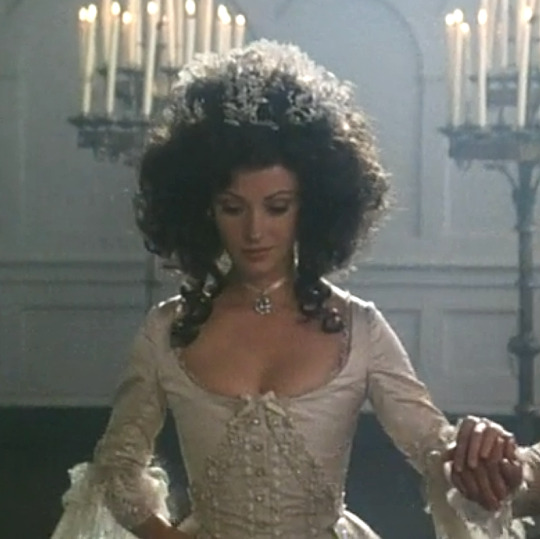
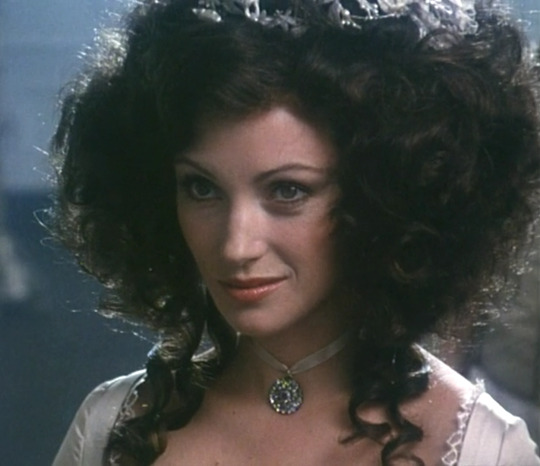



One Dress a Day Challenge
June: Weddings
The Scarlet Pimpernel (1982) / Anthony Andrews as Sir Percy Blakeney and Jane Seymour as Marguerite St. Just
Another well-coordinated wedding pair! I love the embroidery on Percy's lapels, and of course his neckerchief is beautifully arranged, with a jeweled pin to fasten it.
It's always a bit amusing to see hair ornaments in the tall 18th-century women's hairdos. Compare Keira Knightley in The Duchess, here.
#the scarlet pimpernel#wedding costumes#anthony andrews#jane seymour#one dress a day challenge#one dress a week challenge#television costumes#tv costumes#1790s style#1790s fashion#wedding dresses#phyllis dalton#movie costumes#18th century costumes#the scarlet pimpernel 1982#marguerite st just#filing this under both movie and tv because it was originally a miniseries but available as a movie today
62 notes
·
View notes
Photo

Jacket (kassekijntje)
1775-1800
The Netherlands
Peabody Essex Museum (Object Number: 2012.22.13)
#jacket#fashion history#1770s#1780s#1790s#18th century#rococo era#floral#flower print#red#cotton#the netherlands#dutch#peabody essex museum#there is SO MUCH happening with this garment#also it seems this style seems to be confined to literally ONE town in the netherlands#i'm currently reading a scholarly article on it
768 notes
·
View notes
Text
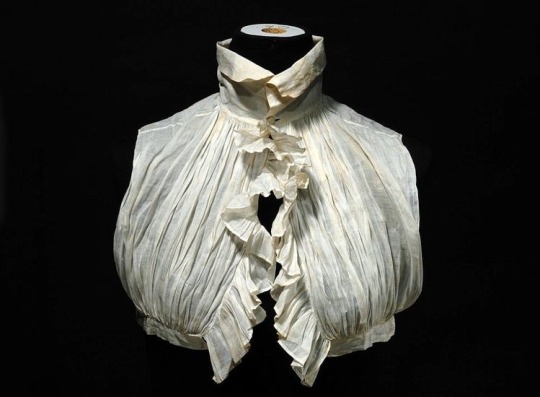
Chemisette with a stand-up collar and a ruffled jabot
1790-1800
Bayerisches Nationalmuseum
#chemisette#fashion#fashion history#empire#empire waistline#empire style#1790s#1700s#1800s#1700s fashion#1800s fashion#history of fashion#high collar#high-collar#ruffles#ruffle#regency#regency era#regency fashion#napoleonic era#napoleonic#cotton#women’s fashion#historical fashion#period fashion#vintage fashion#pirates#pirate#jabot
76 notes
·
View notes
Photo
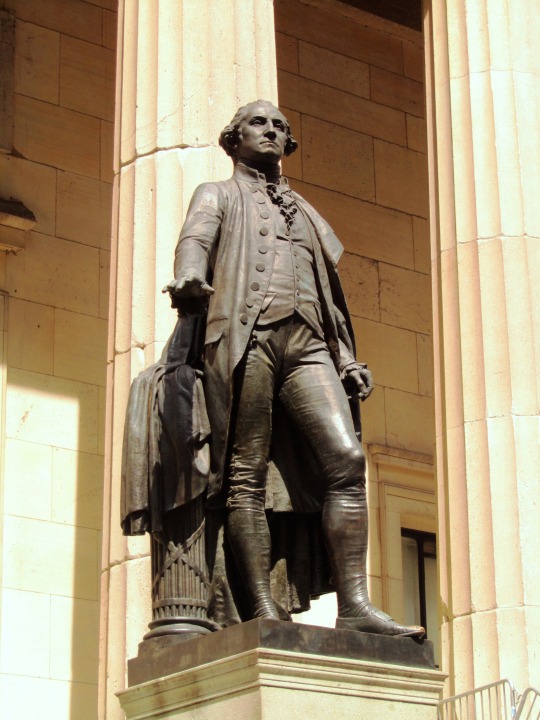
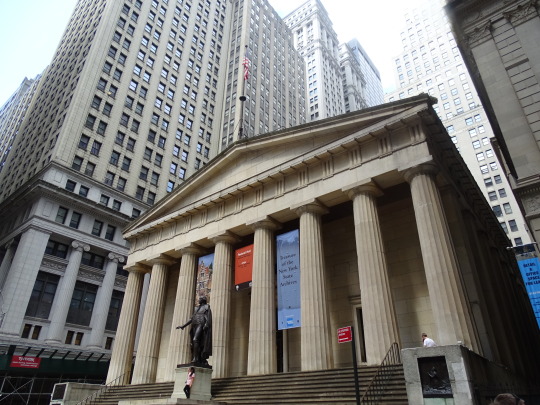





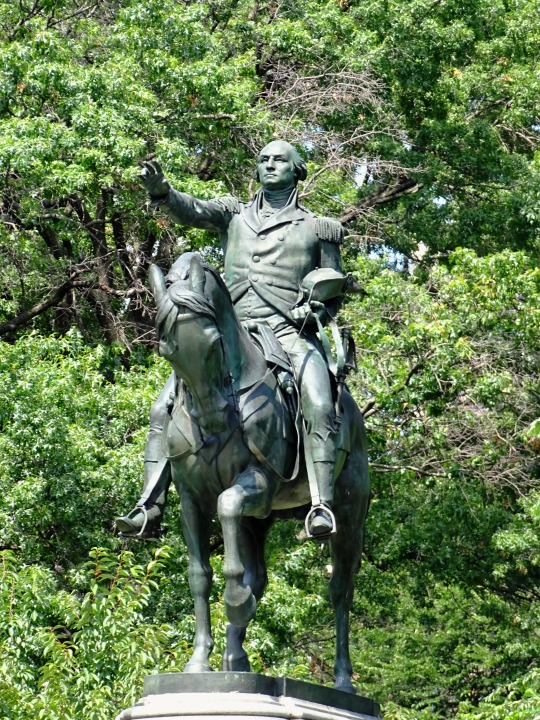
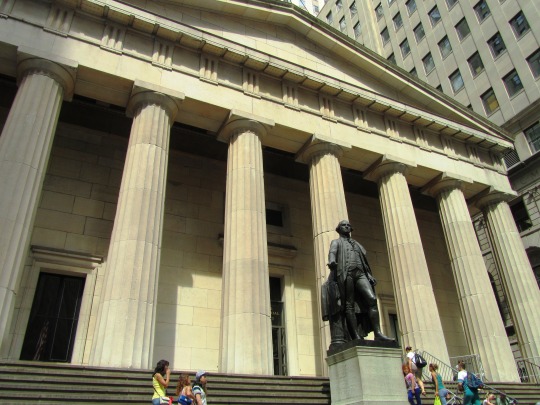

George Washington delivered the first State of the Union address in New York City on January 8, 1790.
#George Washington#first State of the Union address#8 January 1790#USA#Mount Rushmore National Memorial#Gutzon Borglum#South Dakota#2019#anniversary#US history#original photography#Lower Manhattan#vacation#New York City#Federal Hall National Memorial#John Quincy Adams Ward#Henry Kirke Brown#26 Wall Street#Financial District#Greek Revival–style#Town and Davis#tourist attraction#landmark#architecture#cityscape
3 notes
·
View notes
Photo


Mother and daughter:
Top: 1770-1772 Honourable Theresa Robinson (1745–1775), Mrs John Parker by Sir Joshua Reynolds (Saltram - Plympton, Plymouth, Devon, UK). From Wikimedia; iexposure +5%, shadows 60%, temperature -70% 1764X2876 @144 6.6Mp. According to the peerage (thepeerage.com/p4971.htm#i49710), she was the second wife of John Parker.
Bottom: 1798 Theresa Parker by Henry Edridge (location ?). From tumblr.com/blog/view/la-reinette 2048X2986 @72 2.4Mj. According to the peerage (thepeerage.com/p1031.htm#i10304), she was the daughter of Theresa and John Parker.
#1770s fashion#1790s fashion#Georgian fashion#Directoire style#Theresa Robinson#Joshua Reynolds#Theresa Parker#Henry Edridge#hair ribbons
5 notes
·
View notes
Text
I don't know if you're ready for this BUT American Duchess and the Bata Shoe Museum just launched a collab collection called In Bloom.
They made 3 styles in several colours using 3 styles from the the 18th, 19th and 20th centuries from their current exhibition "In Bloom: Flowers and Footwear", and are currently in pre-sale, with estimated deliveries between July and August 2023.
Let's take a look:
We start at the 18th century with the Primrose shoes, based on their Dunmore model, accurate for 1770s-1790s they are embroidered on satin and are $179 USD while in pre-sale and later will be $199. The original style is in black and pink silk satin, and OF COURSE that's my favourite variation, but the green ones are a close second.



Images from top: 1780s shoes, Bata Shoe Museum / Primrose shoes, American Duchess.
From the 19th century we have this style called Flora, accurate for the late 19th century (1870s-1900), are $230 USD while in pre-sale and later will bee $250. This embroidered boots with satin ribbon laces are probably my favourite style from the collection. Of course my fave colour is black, which is also the colour of the original piece, but the lavender ones are just *chef kiss*:
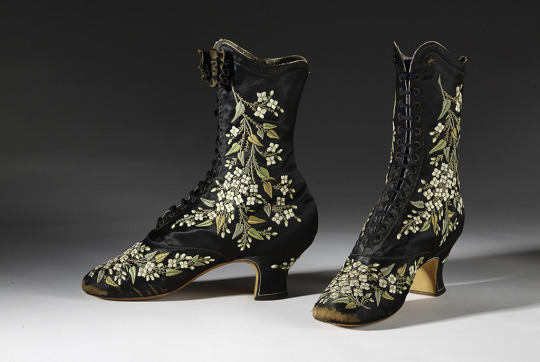


Images from top: the original French embroidered boots by Francois Pinet, late 1870s-early 1880s, Bata Shoe Museum. / Flora boots, American Duchess
Finally, the 20th century style is the Daisy, accurate for the 1920s-1940s. A vintage style full of flowers and colour, this T-strap style is perfect to pair with a simple dress from any decade and have a very decent 6.3cm heel, so you can dance all night in these art deco shoes.
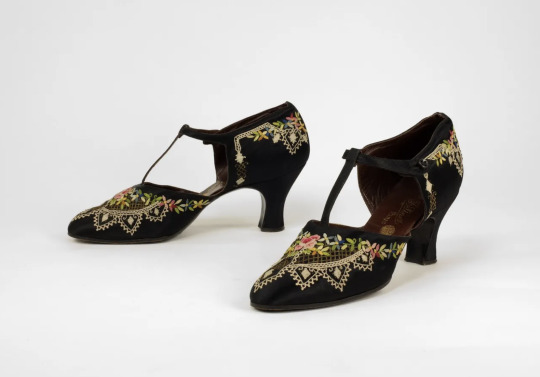
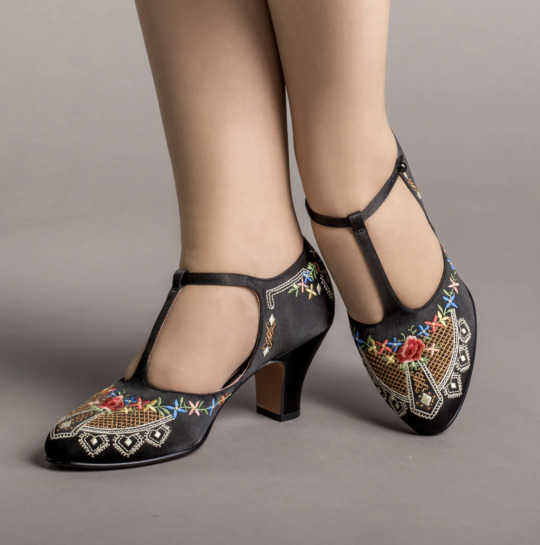
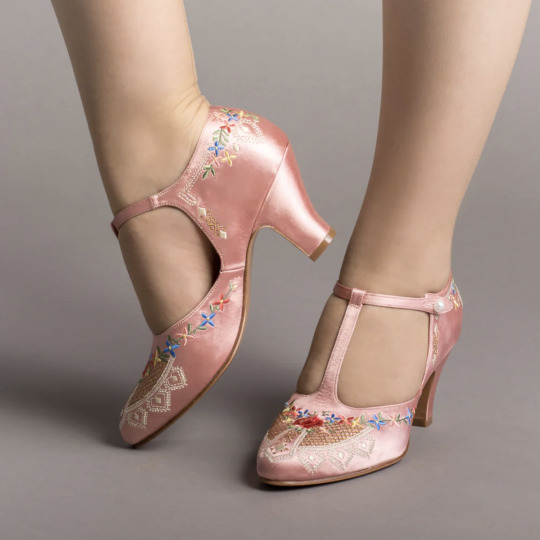
1920s shoes, Bata Shoe Museum / Daisy shoes, American Duchess.
The sales from the In Bloom collection will support The Bata Shoe Museum in their study, outreach, and conservation of historic footwear, and we're here for it.
More info:
"In Bloom: Flowers and Footwear"
Read more about the collaboration at the American Duchess Blog.
Buy the whole collection in pre-sale here.
Which style are you looking for the most?
#shoes#accessories#in bloom#florals#18th century#19th century#20th century#historical shoes#american duchess
8K notes
·
View notes
Text
*📃🖊️*
#Im writing a fanfic for anno 1790 even if the fandom is dead 😂#Probably not gonna finish it or publish it somewere#Im writing in swedish and holy guacamole the way to write their lines is the greatest thing ive done#I mean they speak in a more manner old way#Writing in their speaking style is FUN#I love it!!
0 notes
Note
Top 5 historic clothing items we should bring back into style (stockings on men, big cuffs on coats etc.)
Well I am very biased, because my everyday clothes are mostly 18th century menswear inspired, but for a list as short as 5 it's good to narrow it down!
1. 18th century shirts. Big puffy soft linen shirts. Best shirts. Comfiest shirts. Though tragically, since they get softer with more washing, they're at their absolute most comfortable right before they wear out.
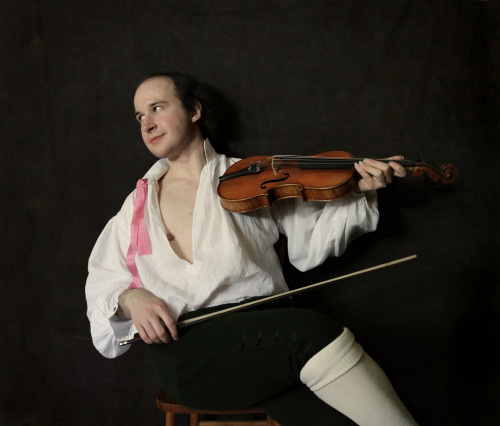
(This one's from the post where I copied the tiddy-out violinist painting.)
Besides being the nicest softest comfiest, they're also the most economical, being made entirely from rectangles. And they're versatile, they look good with lots of different garments! Someday I will do a very detailed youtube tutorial for my machine sewn shirt method. I've done so many now that I think I've finally got it down.
2. Adjustable waistbands. Why did this ever stop being a thing? 18th century breeches have lacing at the back, then in the 19th century trousers have a buckle tab.
Now they do not, even though we're all still humans with bodies that change. (These are my orange silk breeches)

Do you know how many hours of my life I've spent taking in or letting out the waist seams of modern trousers? I don't know either, but I've been an alterations tailor since 2019, so it's got to be a fair amount.
All that waist altering wouldn't be necessary if they still made them adjustable! Waistlines fluctuate, so too should waistbands!!
3. Shoulder capes attached to coats. This was a thing in the late 18th century, and in the 19th, and I think into the early 20th too. It adds extra protection from the rain and snow, and it looks cool.
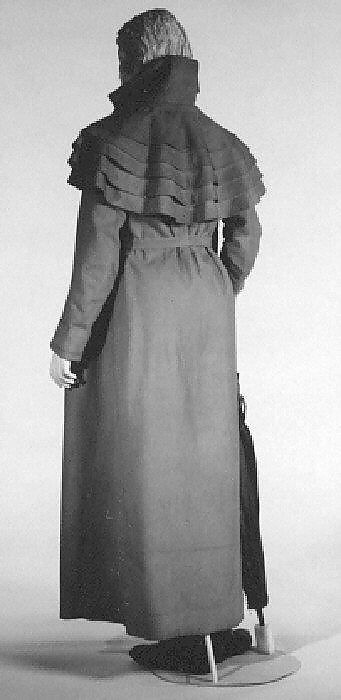
(c. 1812, The Met.)
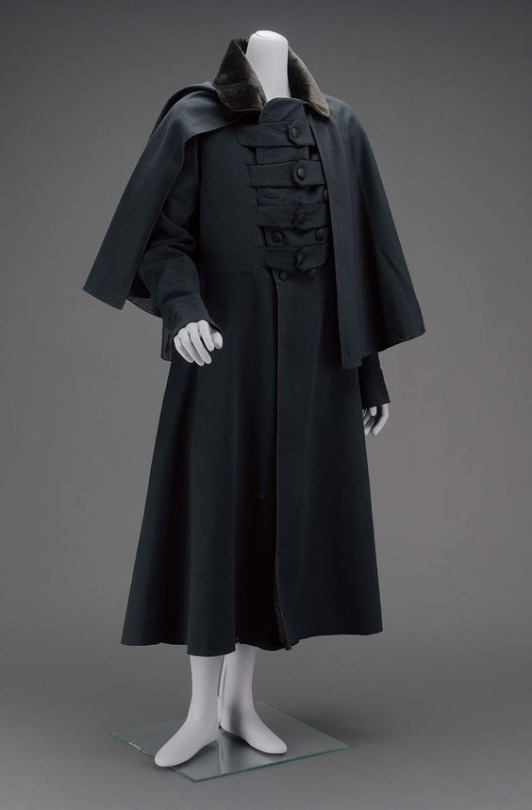
(c. 1840-60, MFA Boston. The cape on this one is detachable)
You can make them long or short, and stack them up like pancakes or just have one. I've got 2 small ones on my corduroy coat, and one on my dark blue wool. Both cut from almost the same 1790's-ish pattern.

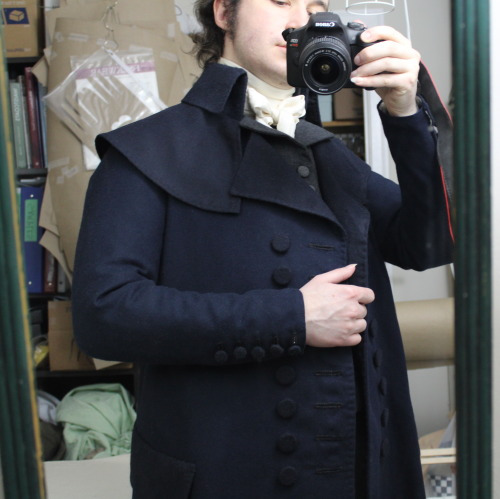
I also want to give a shoutout to fitted sleeves! I love me some two piece sleeves with a distinct elbow! And the coat pockets were bigger back then.
4. Indoor caps. I don't care what era or how fancy you go with it, I just want people to wear caps indoors when it's cold! This one's super simple, it's just a tube of linen tied with a ribbon.


(Detail from Le Marchand d’Orviétan ou l’opérateur Barri by Etienne Jeaurat, 1743.)
If it's cold in your apartment you need slippers for the feets and a cap for the head. Speaking of which.
5. Medieval hoods. This one is wayyy outside my usual era, but the wintery below-freezing weather has just started here and the knit hat I've been wearing isn't quite long enough to cover my ears. I want to make a simple hat with ear flaps, but I also wouldn't be opposed to trying to work something vaguely similar to this into my wardrobe. It looks so warm!
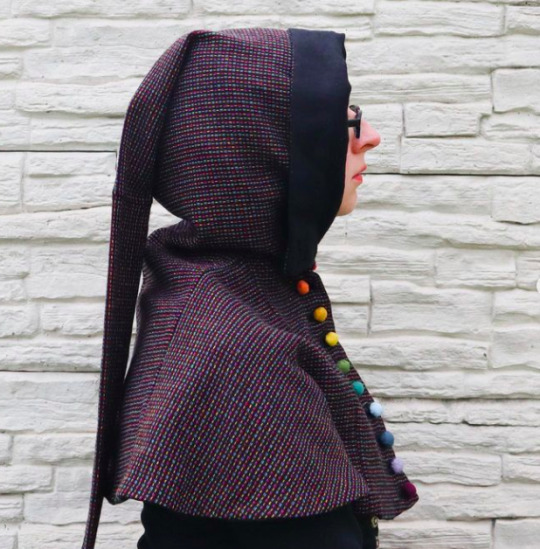
(Image source. Also she has a printable pattern available!)
I actually made one of these once, an entire decade ago. But it was scratchy blanket wool and I've since given it away.
That's some of the main things I think we should bring back! There are lots of other things too, like men's nightgowns, and waistcoats with little scenes embroidered on them, but for this list I tried to be mostly practical.
4K notes
·
View notes
Text
CORRECTED & UPDATED! Clothes + Equivocation = Romance:
The Husbands in 1793
EDIT: I made a significant error when I wrote this. As @goodjomans kindly points out in the comments to Part 2 of this essay (massive shoutout for this, goodjomans! also I love your name!), Aziraphale is the one who dresses the executioner in clothing like Aziraphale's original ensemble, not Crowley. This changes my conclusions about the meaning we can take from this scene!
On the one hand, mea culpa, y'all. I shall get on with eating my crow. On the other hand, I had to go through this frame-by-frame to catch which of the ineffable spouses puts Jean-Claude in his new togs, and the answer only lasts three frames. Here it is:
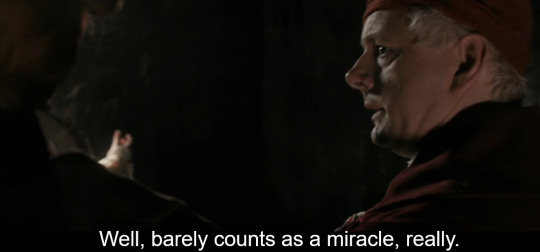
After Aziraphale changes his clothes, but before Crowley snaps his fingers and unfreezes time, there's a shot of the executioner over Crowley's shoulder, and he is now wearing a light coat with gold embroidery on the shoulders like Aziraphale's. Aziraphale arranges the executioner's death, not Crowley. So I feel like an idiot for missing it, but not a total idiot.
Let's discuss how this information changes what we can read from this scene! I'm going to leave my original text in place and edit with bold green. I can still stand by most of this essay, but this detail changes how I read the meaning of the husbands' communication at the end of this scene.
So we're all clear on the fact that the universe of Good Omens is an inescapable nightmare dystopia in which either of the husbands' merciless authoritarian regimes could be watching or listening to them at any time, yes? And that if either are caught 'fraternizing' with the other that means discorporation, torture, memory wipe, and/or death for either or both of them, yes?
Which means Crowley and Aziraphale can never speak or do anything openly to each other about their friendship or attraction or love. Everything they say and do has to have an innocuous meaning they can point to in case anybody ever sees or hears something Team Azcrow can't explain away. Walls (and ducks) have ears, and the price of slipping up--as we see in 1827--is heavy.
When a character says or does something that has two distinct meanings because they need to disguise what they really mean from one party but make their meaning plain to another, lit-nerds (and lit nerds🍃) call this equivocation. Equivocation is a kind of coded communication meant to pass hostile ears and eyes in plain sight but reach its intended recipient with its true meaning. The 1793 scene is jammed with it.
A lot of that coded messaging revolves around the clothes Crowley and Aziraphale choose in this scene, so--THESIS PARAGRAPH, BITCHES--we're going going to talk about how their clothes read to the people of this time period and location, what their clothes tell us about their characters, how their clothes help them equivocate, and what they're really saying with that equivocation. And Spoiler A-fucking-lert, it is ROMANTIC AF PRETTY GD ROMANTIC. Let's get nerdy!
We start with Aziraphale's beautiful champagne-gold and powder-pink ensemble.


This outfit would tell people of this time period 3 things about Aziraphale:
That he's insanely wealthy--These clothes would be silk, hand-embroidered with thread made with actual gold. Each individual garment could cost years' or even decades' worth of working-class wages and take a team of skilled artisans dozens to hundreds of hours to make.
That he's a fop--i.e., a man who loves fine clothes and dressing up and looking fancy. By the 1790s in England, once-fashionable foppishness was giving way to the Neoclassical 'Corinthian' style, and was considered effete. (Fun note: During this time period, effete did not automatically indicate gay, and pink was considered a masculine color, so while Az. is queering it up to the audience here, his clothes would not have read as gay or overtly effeminate to the other characters around him.)
Even though he's insanely wealthy, Aziraphale wears clothes that are decades out of fashion.
According to the Victoria & Albert Museum, "As the [18th] century progressed, the male silhouette slowly changed.[...] Coat skirts gradually became less full and the front was cut in a curved line towards the back. Waistcoats became shorter. The upper leg began to show more and more[...]. Shoes became low-heeled with pointed toes and were fastened with a detachable buckle and straps or ribbon[.]
Source
That description is not what Aziraphale's wearing. Judging by his heel height and the length of his waistcoat, Aziraphale is wearing a style that's at least a decade older than this:
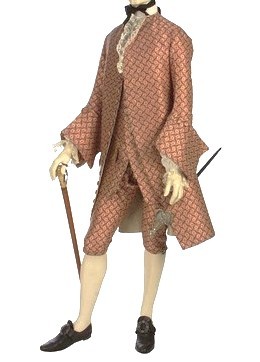
And this is from 1765. The great crepes caper happens in 1793, almost 30 years later.
My inference: Just as he has in the modern period, Aziraphale has settled into a style he really likes and refused to let go of it long after it's gone out of fashion.
We'll come back to this set of Aziraphale's clothes in a bit, but we need to talk about Crowley's first, because Crowley's clothes in this scene help render a line he says later about this outfit very flirtatious and darkly romantic.
First, some background: What was considered acceptable attire for wealthy people in France changed pretty much overnight during the French Revolution after the storming of the Bastille in 1789 and the fall of the French monarchy. Instead of advertising wealth, clothes now had to advertise political allegiance, and they had to do so loud and clear. And if you didn't want to be murdered by the French First Republic, that political allegiance had fucking better be to the Revolution.
People started wearing a looooooot of super patriotic shit. And I mean it was like little kids on the 4th of July; clothes were red, white, and blue in any hue and garish combination and print. The cockade, a fabric rosette in the colors of the French flag, was required by law to be worn by men, and despite that was just as popular among women. To show solidarity with the laboring classes, the fabrics the wealthy wore went from embroidered silk in light Rococo colors (what Aziraphale is wearing) to sober neutrals without decoration in wool, cotton, and linen.
Now, the script note for Crowley's clothing in this scene is this:

But clearly there were some changes made between script and filming, because Crowley does not appear standing behind Aziraphale; he appears lounging.
And he's not dressed as a French peasant.
Here's how French peasants dressed in 1790:

Peasants at this time wore styles that distinguished them from the styles of the upper classes not just in materials, colors, or patterns, but in shapes. Full trousers and cropped boxy jackets in French flag colors were the marks of the laboring-class Revolutionary, and both styles were huge changes from hundreds of years of French fashion up to that point.
And that's not what Crowley shows up wearing. Crowley is wearing the knee breeches, stockings, waistcoat, and frock coat of a wealthy man, and in fact his clothes reference a very specific type of wealthy man.
In the 1790s, if you were an aristocrat who wasn't happy about the Revolution and you were so sure of your privilege that you would risk your life showing it, you wore black in mourning for the monarchy and in protest of the violence of its deposition. If you were an aristocrat who wanted to protest and you didn't want to be immediately murdered by the French First Republic, you wore a style called half-mourning, which was black with a colored coat.
Here's a picture from a 1790 fashion magazine of an aristocrat in half-mourning:

"The text accompanying the plate describes his ensemble as 'half-mourning,' referring to the aristocrats who lamented 'the diminished powers of the monarchy and [signaled] their willingness to die for the royal cause'" [emph. added]. [Source]
Notice: the shoes, stockings, breeches, waistcoat, and cravat are all black. You with me?
Because here's Crowley in 1793:

I've turned up the brightness and exposure in this image so he's more clearly visible against the stone, but I haven't warmed it up. He's wearing a coat that's a dark blackish red. Everything else, even his cravat, even his shirt, is black. (The black shirt is anachronistic, a lovely little nod to Crowley's refusal to wear angelic white.)
This is 179fuckin'3, y'all. Marie Antoinette is executed in 1793. It's 3 full years after that fashion plate up there in his bright red jacket, and that lil dude was already risking his neck way back in 1790. As we can see from the fact that the government are apparently now grabbing random wealthy-looking Englishmen off the street to murder without trial, the time for a man demon to be sauntering around Paris dressed in all black or even nearly all black is well past.
Crowley's also wearing a whole assload of huge silver buttons, which would have been flashy and tacky and frankly pretty weird in 1793 but very definitely an eccentric Rich Person Thing to do, bc regular buttons at this time were horn or wood and covered with the garment's fabric. The only man in France who could get away with this fancy aristo shit anymore was Robespierre himself, and only "devotion to the cause[...] excused Robespierre’s showy dress since he was perceived as a bridge between the politically empowered bourgeois deputies and the ardently antimonarchical unenfranchised classes." [Source]
So when Crowley teases Aziraphale--
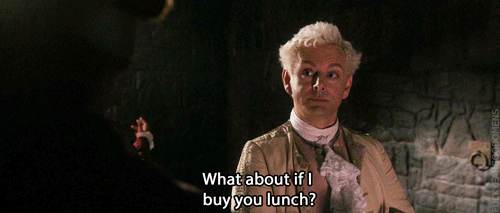

--both of them are perfectly well aware that Crowley's outfit would get him just as killed as Aziraphale's.
And that's why Aziraphale's expression is annoyed when he has abandon his "standards" and change his clothes. Because Aziraphale's the one who needs the favor, Crowley makes him take one for the team and wear the goofy hat.

The clothes Az. changes into here still tell people that he's rich, but they also say he's a hardcore Revolutionary. The red jacket in a current cutaway style, the cockade and sash, and the bonnet phrygien (the red garden-gnome cap) all announce this guy is a huge supporter of the Revolution. His clothes are all still aristocratic in shape and materials (and he keeps his now-unfashionably frilly lace cravat), but he's no longer flaunting obscene wealth in a city filled with angry starving people, and the gnome cap says he's in solidarity with the working classes even if he isn't one of them.
Once he restarts time, Crowley is not leaving that prison cell safely without either changing his clothes or taking Aziraphale with him, because Crowley looks like a rich asshole protesting the fall of the monarchy--which is frankly exactly the kind of thing he'd show up wearing to the Bastille during the Reign of Terror (just like he wears athleisure in Heaven). But Aziraphale's new appearance covers for them both: if the rich-looking guy with no cockade and wearing all black under his almost-black coat is in with this other guy who's obviously a Revolution fanatic, then the rich guy's probably okay, right? He just forgot his sash at home or something. Bees.
Something else happens when Az. changes, too. Look at Aziraphale's new dress from a different angle:
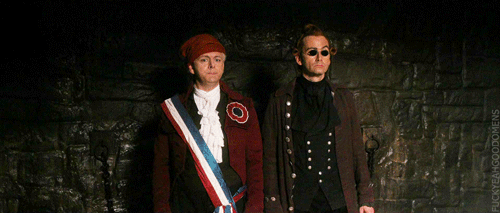
Half-mourning is a white shirt, but a black cravat, so this isn't half-mourning. He's wearing three different badges of the Revolution to make up for the fact that Crowley looks like a Satanic libertine (which tbf he is), but Aziraphale's new ensemble is black and dark red.
Y'all. Aziraphale changes into Crowley's colors.
Now, this is a more fashionable and higher quality version of what the executioner is wearing, so Aziraphale has very plausible deniability here; if anyone ever pulled him up on it, he could say he just copied our man Jean-Claude.
But let me show you what English fashion looks like right now:
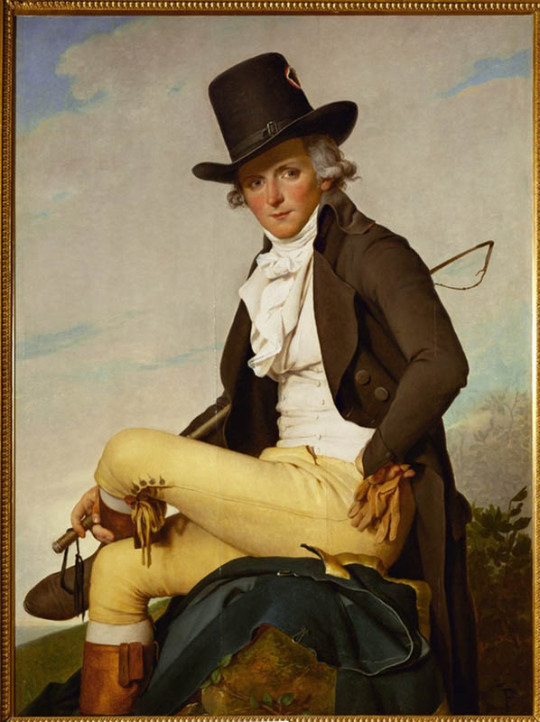
This is a French painting of a wealthy Frenchman, but he's wearing the English 'Corinthian' style. It was painted in 1795, so this would have been the very cutting edge of fashion in England in 1793, and the fabrics and colors look right at home in Revolutionary Paris. (He's wearing the cockade on his hat, btw.)
Look at all that angelic white! The buttery almond of the buckskin breeches, the golden kidskin gloves, the rich tan of the riding boots! The blue of the greatcoat! All colors we know Aziraphale prefers!
And yet this is what Aziraphale chooses:

We know from the entire rest of the show how very particular about his clothes Aziraphale is. And yet 150 years before he (accidentally) admits in words that he's Crowley's friend, Aziraphale wears Crowley's colors to take him to lunch to say thank you for a rescue.
When we decide whether a character's speech or action is equivocation, one of the things we check is whether equivocation (and deception generally) is something that character does elsewhere in the text, which, with Aziraphale, hahahahaha, DUH. He's already using equivocation in this scene.
The lunch date itself is equivocation on Aziraphale's part. Aziraphale tries to thank Crowley for the rescue, but Crowley says,
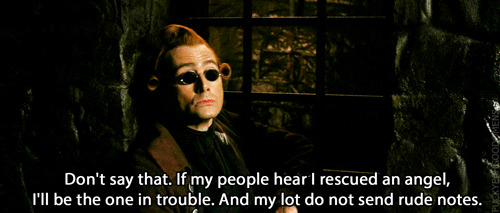
So Aziraphale says,

No more words like "thanks" or "rescue" used, but a couple hours of good food and drink and conversation, Aziraphale hopes, will express the gratitude toward Crowley it's not safe to speak aloud. With this, Crowley and Aziraphale explicitly establish that they are equivocating for each other's safety and using coded communication--immediately before Aziraphale changes into Crowley's colors.
So yes, Aziraphale may well copy the executioner's clothes. But consider: When a character who can't speak or act openly says or does something that has two or more possible meanings, this can be read as equivocation.
We don't get a face reaction from Crowley about Aziraphale's new 'fit, so we can't be sure how he feels about this. But this whole scene is, even on its surface, about 1) the meaning clothes transmit to a viewer ("Oh good Lord," says Aziraphale when he sees what Crowley's wearing) and 2) how to show gratitude and appreciation when you can't speak of them openly. And we know Crowley notices clothing and clothing colors, because look at what he wears, like, ever. So it's very reasonable to presume he notices Aziraphale wearing his colors, and it fits well with both the rest of Crowley's actions in this scene and with his being very hurt and angry when Aziraphale later characterizes their interactions as "fraternizing."
Right, so we've covered what's going on with the husbands' clothes, and we've looked at two examples of equivocation on Aziraphale's part, viz., lunch and his change of colors. (Here's an example of equivocation on Crowley's part as well.) Now let's look at that super interesting thing Crowley says about Aziraphale's first outfit.
Here's the line:
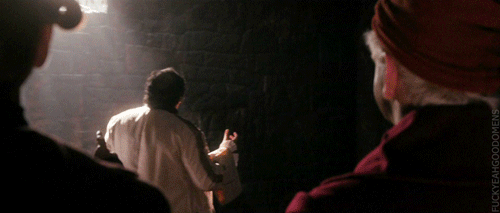
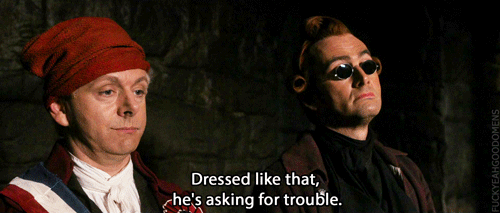
Crowley follows up here on earlier lines in which he teases Aziraphale for coming to Reign-of-Terror Paris for crepes: "Dressed like that?" meaning Aziraphale was guaranteed to get arrested dressed like an aristocrat. The top layer of equivocation is always an innocuous meaning: the plausible deniability meant for the hostile/unsafe listeners. That's Meaning 1.
But "Dressed like that, s/he's asking for trouble" means two other things, too. It's a veeerrrrry familiar phrase, isn't it? We've all heard that arrangement of words in that order before. It's used when people think someone (usually but not always a woman) is dressed to invite sexual attention.
How do we know we're supposed to take this modern meaning from this phrase? This is how:

We have learned in literally the previous sentence to this one that rain has not been invented yet. The only two humans in existence have just left the Garden. Balloons definitely do not exist yet, humans couldn't tell you what lead is, and yet this is a phrase Crowley uses and Aziraphale understands. This tells us, the audience, in the very first line of the very first scene with these characters, that their speech is anachronistic and modern, and that we are to understand their phrasing in its contemporary sense.
So. When Crowley says "Dressed like that, he was asking for trouble" in 1793, we should read that in the context of the scene and in the senses the phrase carries to us today.
And since Crowley is using a phrase that means the executioner is dressed to invite sexual attention, and the executioner is wearing clothes identical to Aziraphale's, then Crowley is necessarily telling Aziraphale that when Aziraphale was wearing those clothes--those frilly, effete, unfashionable-for-decades clothes that nobody else likes and the French now murder people for wearing--that was, in Crowley's view...provocatively sexy. Meaning 2.
"Dressed like that, s/he was asking for trouble" is also what people say to justify violence, especially sexual violence against women and queerphobic attacks against men perceived as gay or just 'insufficiently' 'masculine'. In fact justifying assault is likely the most common way this phrase is used today by a wide margin. Meaning 3.
Crowley's joke isn't even really a joke in this sense; it's a vicious barb. And, because it must, it sounds like it's at Aziraphale's expense: You wore the wrong clothes, you weren't careful enough to guard yourself against the men who want to do you harm, so you deserved the trouble you got. Meaning 1.
Except remember: Crowley is also dressed for trouble. And Aziraphale is aware of this. Crowley's 'fit would be almost as offensive to the Revolutionary French of 1793 as Aziraphale's Rococo pastels, and probably just as likely to get him arrested and murdered by the state if he weren't making letting Aziraphale keep him safe by wearing the cockade and the silly hat. Crowley's not saying anything about Aziraphale here that he's not also saying about himself; and as we know from Aziraphale's initial "Oh good Lord" when he turns around and sees Crowley's black and red half-mourning (with extra black and gobs of silver), Aziraphale knows it.
Then why the rapey joke, Crowley?
This is fucking why:
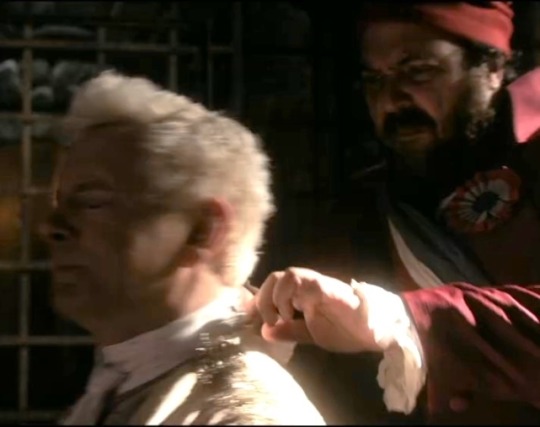
Crowley rocks up at the Bastille just in time to witness some grubby fucker assault his friend. Assault the person Crowley will greet 15 seconds after this as angel.
Crowley's first act after freeing Aziraphale is to send this dude to his death. Nope! Aziraphale is the one who arranges to have the executioner killed in the clothes he would have killed Aziraphale for wearing. He takes Jean-Claude's ability to speak (but not to make sounds, interestingly! Jean-Claude can still whimper, Jean-Claude can still cry!) so the executioner can't tell anyone about the 'mixup.' It's unclear which of them blocks the executioner's power of speech. The vicious joke about assault in Meaning 3 isn't at Aziraphale's expense at all. It's not You wore the wrong clothes, so you deserved the trouble you got. It's If this guy thinks you deserve trouble for wearing the wrong clothes, he can eat his own rules.
And that's the other piece of evidence that, along with Crowley's ensemble, shows us the audience and Aziraphale which meanings Crowley intends with his equivocation. Meaning 1 is cancelled out by Crowley's clothes. That leaves Meanings 2 and 3.
Crowley and Aziraphale share clothes as a common interest. They don't have the same style, but they're both aware of current fashions, and Heaven and Hell aren't. You can't tell me Hastur or Uriel would recognize the significance of Crowley saying "Dressed like that, he's asking for trouble" about someone else while wearing black stockings and cravat and waistcoat himself. And that means Anything the husbands communicate to each other through clothing choices goes undetected by their masters.
SO. With all this in mind, let's go through the 1793 scene again and look at what their clothes help them say without words.
Concluded in Part 2!
#good omens#good omens 2#good omens s2#good omens costumes#good omens fan theory#good omens meta#good omens analysis#aziracrow#azcrow#ineffable husbands#aziraphale x crowley#azicrow#good omens 1793#good omens 1984#good omens clothes and equivocation
548 notes
·
View notes
Text
I watch a fun IG reel of a maid getting dressed in 1790 vs. 1890. it's great! both maids are in practical, period-typical outfits with a few simple aesthetic touches because Humans Like Looking Good regardless of social class. you can tell they are maids because they put clearly functional aprons on, and the 1890s one is wearing a uniform-style cap. also the caption says they are. love it
I scroll down
the top comment: "but what did POOR women wear? you only ever show rich people's clothes!"
#dress history#fashion history#historical costuming#perhaps...working women...had nicer clothes than you realize?#perchance they...did NOT go about in rags?#shocking to even consider I know!#also if they're not being educational historical costumers don't owe you working-class ensembles in their fun personal hobby#but that's another conversation#(I'm a normal person 24/7! let me be a countess for a while!)
795 notes
·
View notes
Text
Regency Era Accessories Part 4:


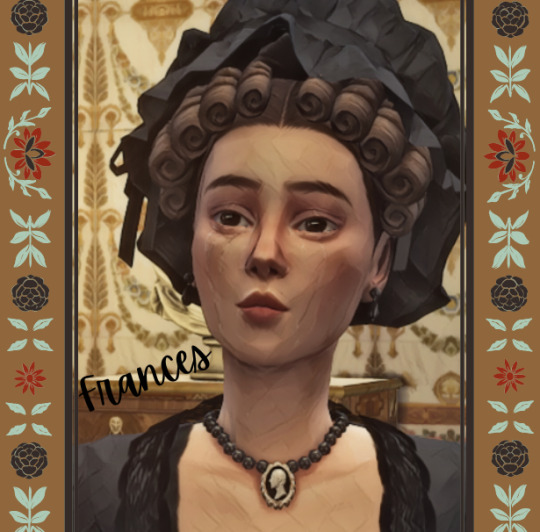
I've converted these lace caps from Sims 2 creators maya40 and Simbury, when downloading please read the description.
Aren't you sick of your married maidens not having proper attire to cover their lovely locks? Perhaps your spinsters are also in need of covering their hair to avoid more shun than they're already exposed to in society. How scandalous your married lady sims must feel straying away from God with their hair uncovered! Allow me to present you 3 lace caps for your ladies to wear during the day.
Julia: A laced day cap with a front ribbon used for morning and daywear during the early Regency Era (1795-1837) but this style will work for 1810s-early 1820s
Sophia: A small fitted lace day cap with side ribbons used for morning and day wear. I suppose if you'd like you can slap this one on for some formal dinner parties too, but I think my turbans work better for that. I used separate textures from the original mesh by Simbury and slapped some ribbons on there too. My inspiration was to get a cap like Louisa Hurst from Pride and Prejudice 1995. Meant for the Regency Era (1795-1837) but this style worked for the late 1790's-early 1820s.


Frances: Same as Sophia Cap just bigger and less fitted. Works for more elaborate hairstyles.
BGC and Hat Slider Compatible
Pics of actual Lace Caps down here. You may hear them referred to as either Mob Caps, Dormeuses, or Lace Bonnets, but I'm just going to stick with lace caps as that's what I've always called them. If you were alive back then you would've called it a Bonnet but I apologize I was born in the 2000s.

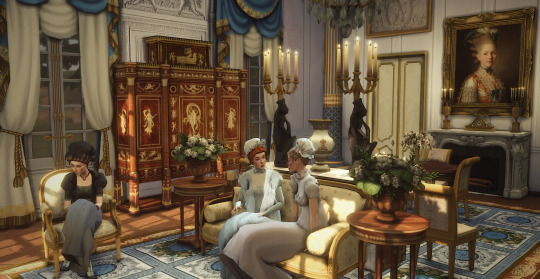
Ah, what a lovely day for gossip between 3 married upper-class ladies. What else would they rather spend their day doing?

I wonder what Julia and Sophia are talking about? Perhaps Julia caught her husband leaving the male servant quarters half undressed in the early hours of the morning with his clothes all undone. That would explain that sly look on Sophia's face. It's fine, they got into an arranged marriage anyway and he's rich so of course she won't say anything.

Poor Frances seems to be sulking in a corner and oh she's in black, she's mourning. I wonder for who? Oh no, are those tears I see?! Perhaps this conversation brings back painful memories of her late husband too! He had his fair share of dabbling in bed with his male servants as well...
DOWNLOAD
#sims 4 regency#ts4 regency#regency sims 4#sims 4 historical#simblr#sims 4 regency era#regency ts4#historical sims 4#historical cc#historical sims#ts4 georgian#georgian cc#my cc#ts4 cc
257 notes
·
View notes
Text
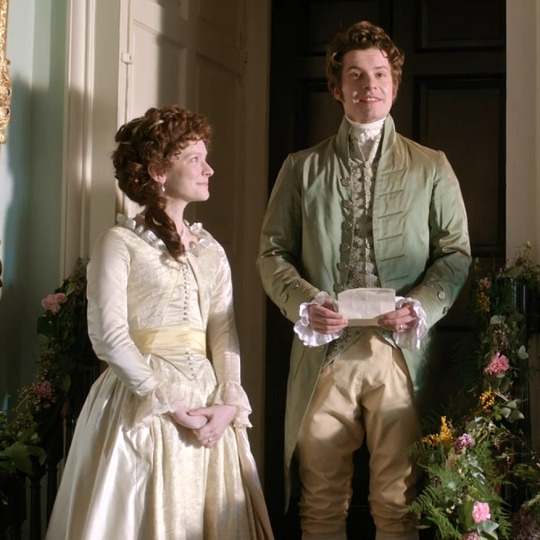

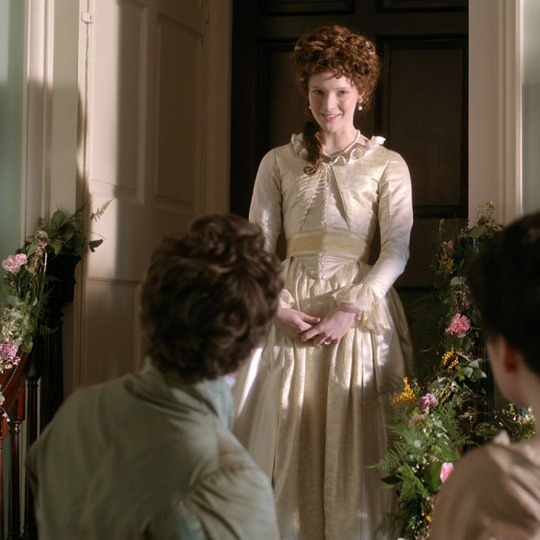
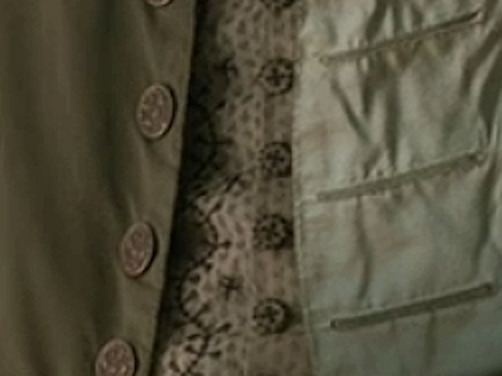
One Dress a Day Challenge
June: Weddings
Love and Friendship / Morfydd Clark as Frederica Vernon and Xavier Samuel as Reginald de Courcy
Frederica wears a cream or pale yellow gown with a yellow sash, pearl earrings, and a gold ribbon in her hair. Reginald wears a sage-green coat over an embroidered waistcoat of similar color, and buff-colored knee breeches.
It's a shame we don't get to see what Lady Susan and Sir James wore for their wedding, though!
#love and friendship#wedding costumes#morfydd clark#xavier samuel#movie costumes#one dress a day challenge#one dress a week challenge#period film#18th century costumes#1790s#1790s fashion#1790s style#18th century style#18th century fashion#2016 films#2016 movies#Eimer Ni Mhaoldomhnaigh#austen adaptations#lady susan
32 notes
·
View notes
Note
Good sir, I am hoping to pick your brain. I’m making an 18-century (“pirate”) shirt as a gift to my friend. He wants tie closures on the neck and cuffs instead of buttons. Might you have any insight or resources for this? I’ve seen the ties in at least one of the extant shirts I’ve viewed online. I’m still pretty new to the sewing gig and I’d like to minimize inventing metaphorical wheel as much as possible. Thanks in advance!
It's very unusual, but do know of one example! (Not that extant one though)
But first - Link to my most thorough shirt construction blog post. (It's a few years old and I've improved a few little things in my technique since then, and I mean to finish writing a new and better one before the year is over.)
Ok, ties on shirts!
I'm assuming this is the extant one you're talking about? Tbh I'd discount this one entirely if you're looking for information on 18th century men's shirts because I don't think it is one.

Besides the attached ties, the sleeves are extremely weird. They're cut off and have no wristbands!! This would make it quite impossible to wear under a coat, the wristbands are an absolutely essential part of an 18th century shirt.
I also don't see any reason to believe this is actually 18th century when it could just as easily be 19th century, and considering how short the slit is I think that more likely.
(Lots of auction sellers like to say "late 18th century" about things that are like... yeahh maaaaybe that's plausibly from a very fashion forward guy in the late 1790's but it's much more likely early 19th century. And with court dress they sometimes just straight up date it several decades too early. Look at lots of examples and always question everything, because museums don't always date things correctly either.)
I think I remember seeing someone mention once that it was a 19th century workman's garment of some sort, but I can't remember where, and all we've got to go on are a few pictures and a brief caption from a seller who doesn't know what they're talking about. It does look like it could have been worn over another layer though, and the fabric is very coarse. It could also have been altered at a later date for theatrical costume, which is something the Victorians did to A LOT of 18th century garments.
So just ignore that shirt!
The vast majority of 18th century mens shirts close with 2 or 3 buttons on the collar, but there is a style that uses ribbons. It appears to have been fairly common in the late 17th and early 18th century, and then slowly dwindles as the century goes on. I have a section for it on my shirts pinterest board with 64 examples. Ooh, wait, 65, just found a new one.
The collar is made with little to no overlap and one buttonhole on each end, and a ribbon is threaded through them.
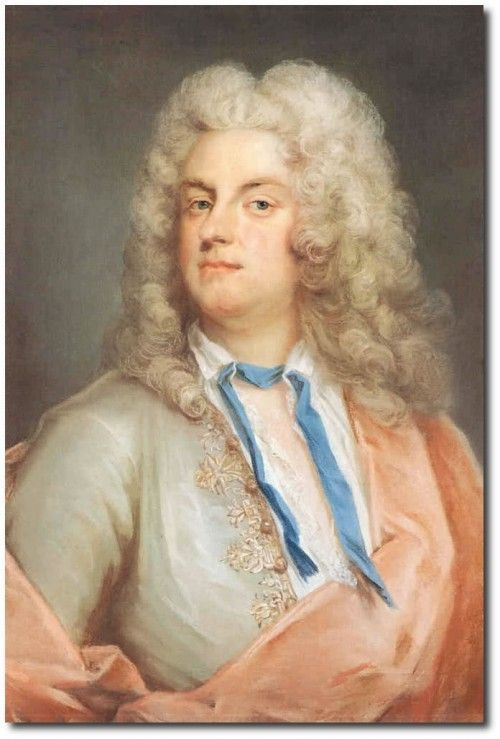
Portrait of Carl Gustaf Tessin, 1728.

Sir Charles Howard, 1738.
I actually made one of these last year!

The collar doesn't sit as well with the ribbon as it does with 2 buttons, but once you put a stock over it it's fine.
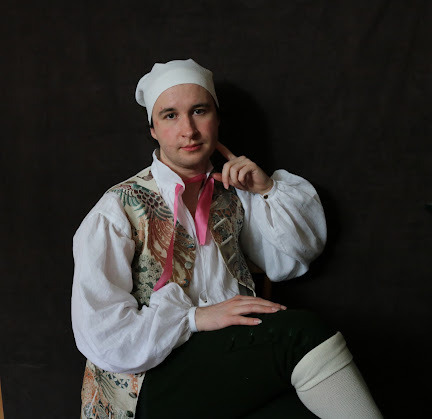

Nearly every single depiction of an 18th century shirt I've ever seen (and I've spent a LOT of time looking) uses sleeve links on the wristbands. (Which I have a tutorial for! They're really easy to make!)
I do sleeve links on most of my everyday shirts because I like them better than sewn on buttons. When the wristband is this narrow, sewn on buttons don't sit very nicely.
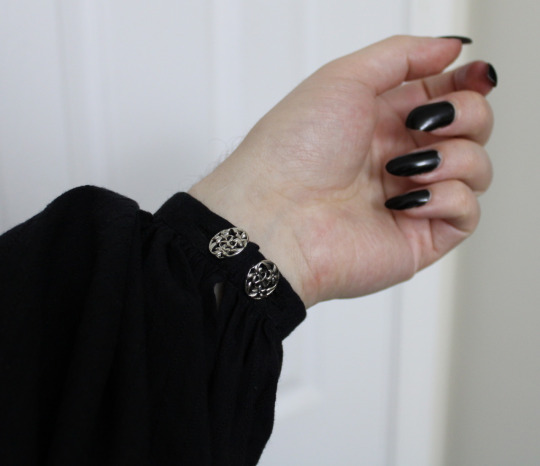
But! If your friend wants ties on the wrist in a historical way, I do know of one single example, and it's this guy!
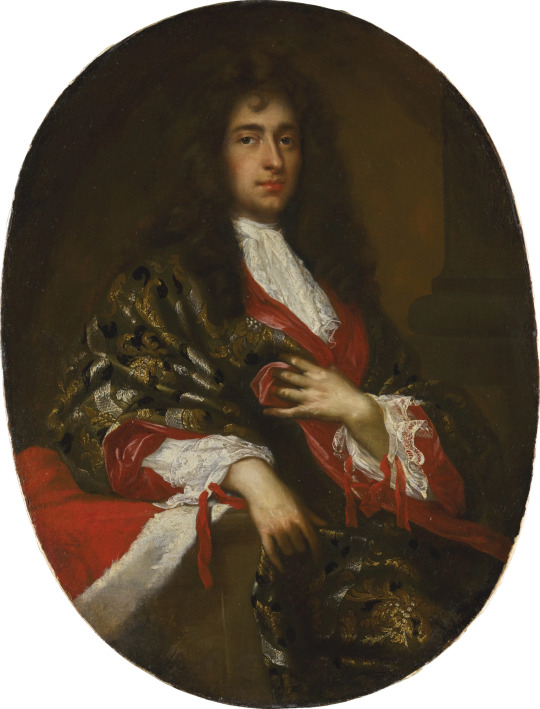

Giovanni Maria delle Piane, Portrait of a nobleman. No date given, but if I had to guess I'd say 1680's or 90's. Very late 17th century looking fellow.
We can't see his collar closure, but I think it's very possible that he has a matching red ribbon holding that closed.
Personally I wouldn't want to try these, because they look like an absolute nightmare to tie by yourself one handed. But the good news is that you could make just regular wristband that take sleeve links and they'd work for this too, since both just have a buttonhole at each end!
I aim for a finished wristband length that's 10-14mm longer than my wrist measurement, with the buttonhole being about 4 or 5mm in from the edge, which gives me enough ease to wear them comfortably with sleeve links, so if you do that then he'll be able to wear them both ways.
287 notes
·
View notes
Text
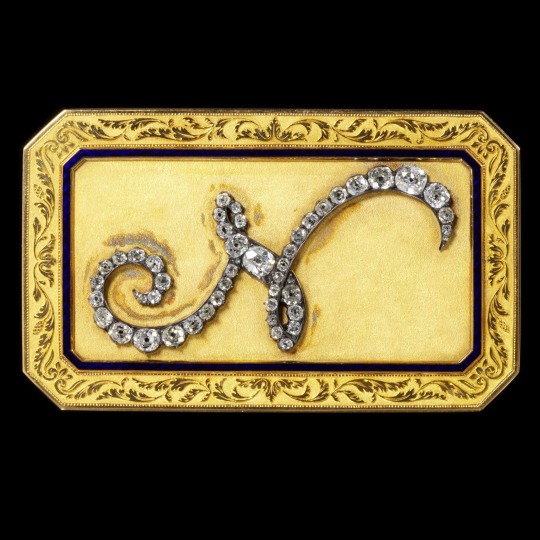
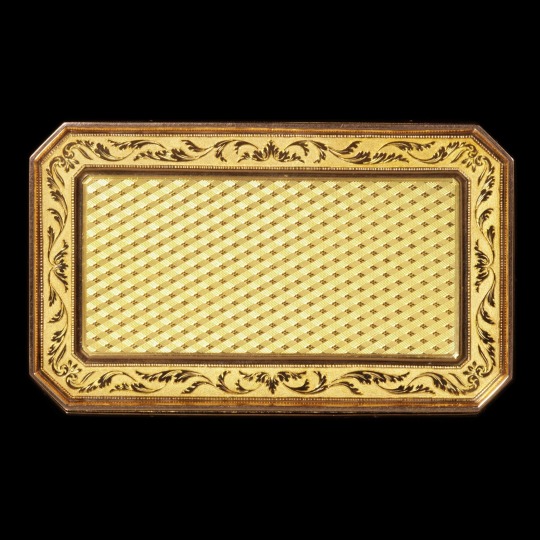

Box, 1798-1809
Etienne-Lucien Blerzy (maker)
Nitot & Fils (maker)
Gold box, set with brilliant-cut diamonds in the form of the initial of Napoleon I, within an enameled border
Source: V&A Museum
#box#napoleonic era#napoleonic#empire style#french empire#19th century#first french empire#french art#French#art#empire#France#history#Etienne-Lucien Blerzy#Nitot & Fils#1800s#1810s#1790s#18th century#neoclassical#court#gold#diamond#Napoleon#napoleon bonaparte
90 notes
·
View notes
Text
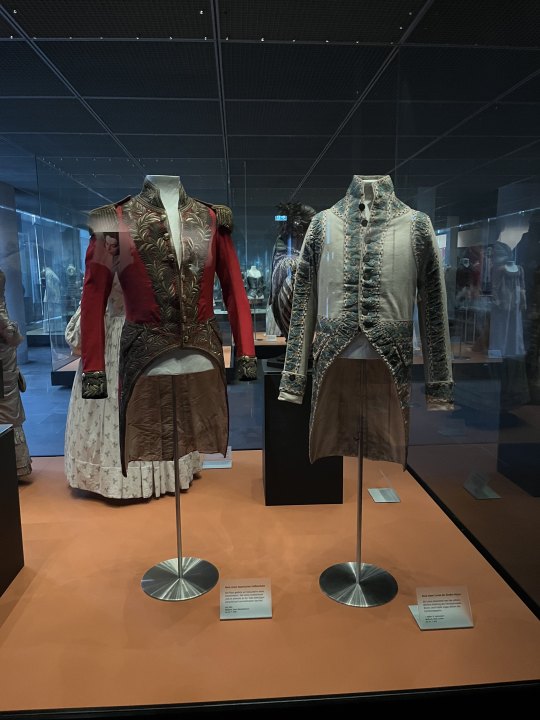
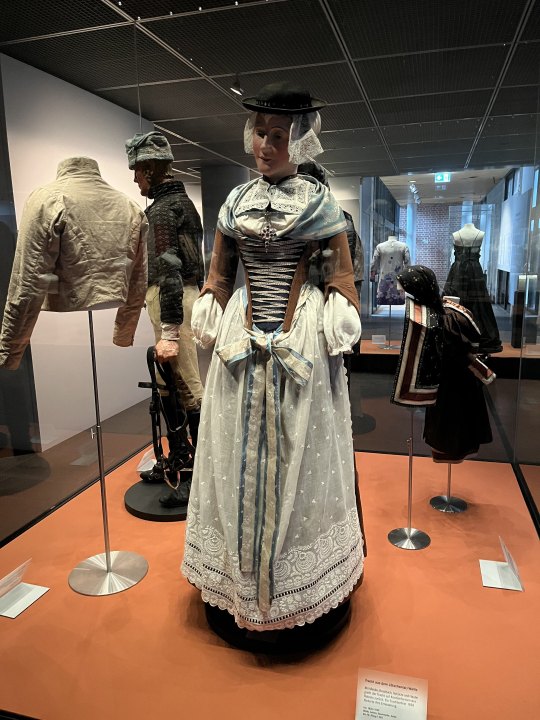

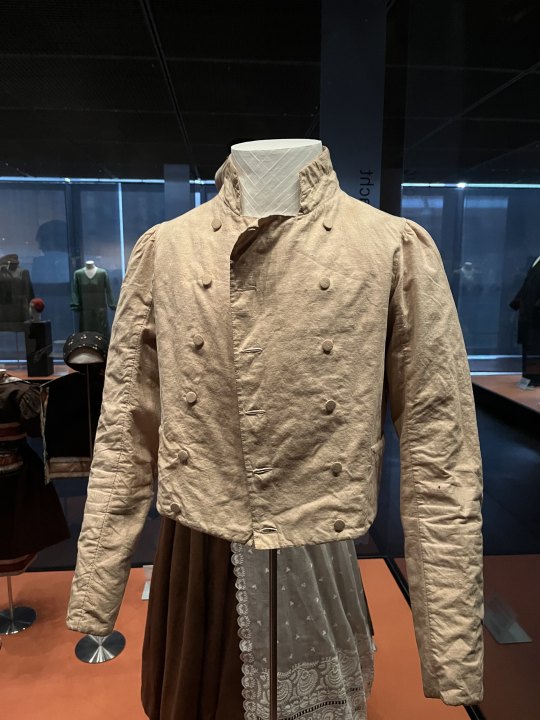
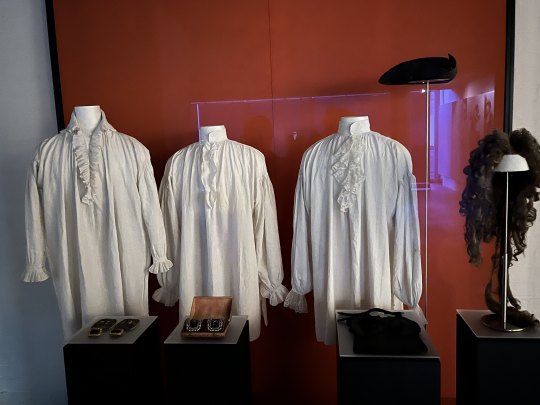



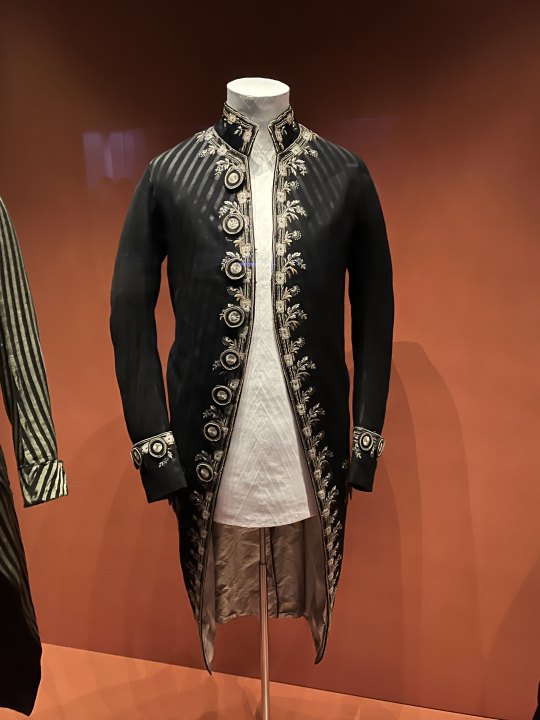

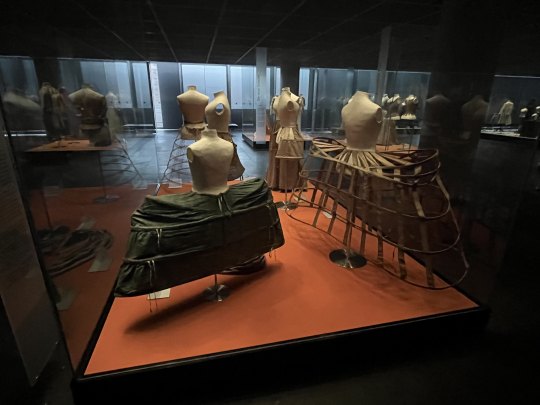
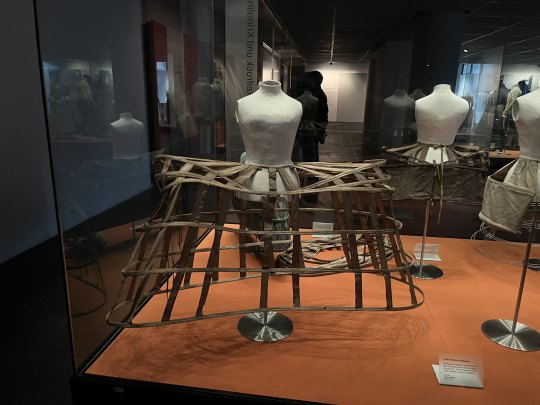
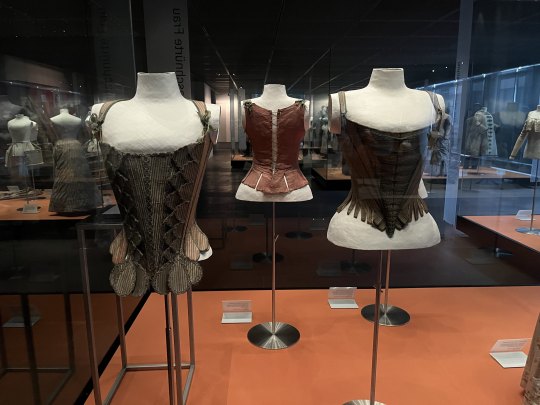

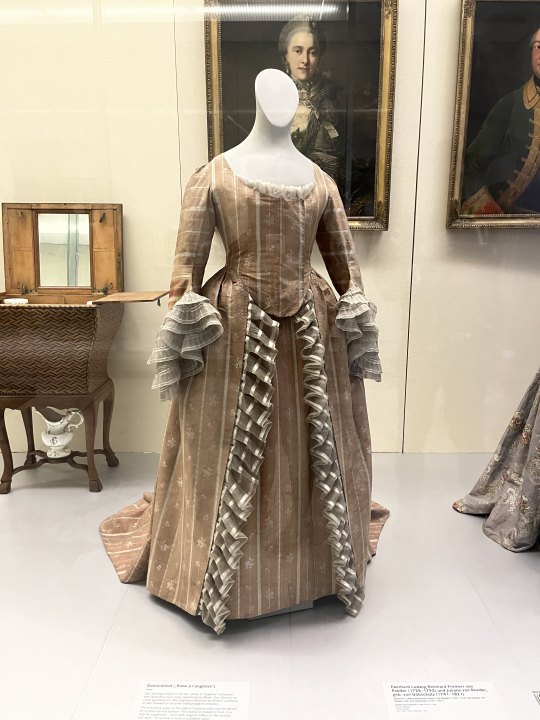
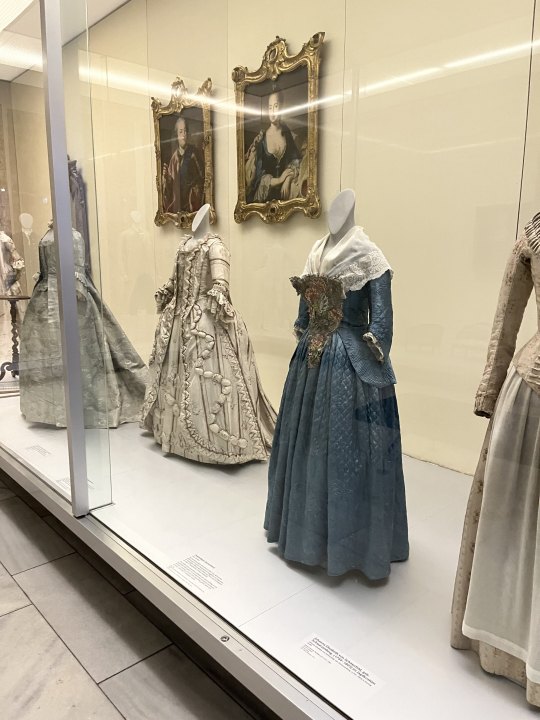
And here, as promised to the dear @vinceaddams come a lot of extant Garments from my recent Visit at the German National Museum in Nuremberg. I am trying to give as much Information about each Picture as I can though unfortunately not all of the Pictures were taken by me and I could take Pictures as extensively (including Info Signs) as I would have wanted, lest I be abandoned in the Clothing Section. Also the whole Section was awfully dim, which made it rather difficult to read some of the Signs. The last three Pictures were taken in a different Section, thus the more pleasant Lighting.
Servant Livery, bavarian Court, mid 19th Century (left); Servant of the Count of Cannotreadhisname, first half 19th Century (right)
Woman's Folkdress, Lötschental/Wallis (Switzerland), Museum dates it 1830/1905 which is an awfully broad Range, but maybe it was altered later; shows wonderfully how late 18th Century Styles were preserved in european Folkdress that came to be in the 19th Century proper
Various Men's Garments throughout the 18th Century, as there are Closeups of each, the respective Detailinformation will be provided further down.
Men's Spencer, c. 1810s-1820s, Linen and Cotton, the Sign didn't say it explicitely but due to it's Placement in the Exhibition and comparable other Pieces I have seen, I think this is more of a common Man's Piece of Clothing.
Three Men's Shirts, various Shoebuckles, a cocked Hat, a Periwig and what I assume to be a Hair Bag. This Display Case had a rather badly illuminated Sign, so sadly I have no further Details about the Pieces.
Justeaucorps, c. 1695, Wool, Silk, Metal Trim.
Waistcoat, c. 1695, Silk, according to the Museum it was worn together with the Justeaucorps, which seems to be a nice Colour-Combination.
Breeches, 1790-1800, Silk. Very pretty Pair, but the bad Lighting doesn't really let it show.
Habit à la francaise, c. 1790, Wool, Silk, Embroidery (What a Material Specification...). I really like the Combination of those subtle dark on dark Stripes and the Embroidery.
Tailcoat, c. 1790/1795, Cotton, Silk, Linen, really peak 1790s Look honestly.
Very wide Court Panniers, with Pocket Hoops and Crinoline in the Background. Alas no Detail Information for this and the next two Pictures.
Frontal View of the Pannier. I suppose I have to get one of those at some Point, if only for how extra they are.
Three Pairs of Stays, two from the Front, one from the Back. Sadly I don't feel confident enough to Date those and I have no Pictures showing the Info Signs well enough.
Lots of pretty Dresses that were exhibited in another Section of the Museum. The right one is a Robe à l'Anglaise, but that's all I can tell.
Another beautiful Anglaise, notable for being preserved in its Entirety with original Ruffles.
More pretty Dresses. Unfortunately due to Time Reasons I have no Pictures of the Suits displayed across the Dresses in the U-shaped Display, though I have to say one of them had a very much not authentic Lacebib hanging from the Neck...
That's all the cool Clothing Pics I have, at some Point I will return and take loooots more Pictures from all the Angles too. Also at some Point I might write to the Museum about the Lighting, there surely is a better Solution when having your Objects barely visible with unreadable Signs while still protecting them from UV-Rays.
Bonus-Pic 1:

Me, in historical Dress, c. 1750 (minus the Shoes), standing in a historical Kitchen.
Bonus-Pic 2, for the Boat-Crowd:
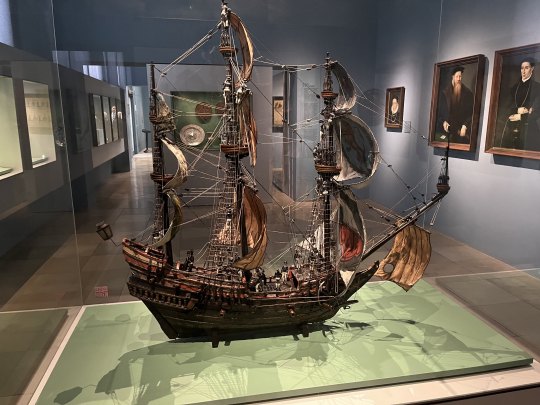
Beautifully detailed Modell Sailing Ship, early to mid 17th Century if I remember correctly. Interestingly enough all the little Sailor Figurines on it were very much early 19th Century in Style, so I assume the previous owner had those added at some Point, before the Museum acquired the Model in the late 19th Century. (The Incongruence sadly wasn't addressed on the Info Sign, so I might contact them about this too.)
#Aus dem Leben einer Taugenichts#Extant Garments#Historical Fashion#Germanisches National Museum#18th Century#19th Century#Museum
156 notes
·
View notes
Text
In Aeternum
Fandom: Castlevania series (2017-2021)
Relationship: Alucard x Reader
Count: 2.2k
Rating: M
Tags: Pining, Alternate Universe, First Meetings, Dark Romanticism/style, Castlevania References, Reincarnation, Post-Castlevania 2017-2021, Graphic Depictions Of Violence, AFAB Reader, F!Reader, Herbalist Reader, Magic, References to Speakers, Creatures, Shapeshifting, Second Person POV
AN: Bringing back a story written on the old blog for an ask (I believe it was from @mightyarsh? Let me know if not!). Oneshot for now, TBC if there's interest for more.
Edit: here's Part II
Summary:
Alucard centered story, where his s/o in ~1476 is a herbalist who eventually dies of old age. Fast forward to the 1790s, Alucard stumbles into you: a herbalist and magician, with the same appearance of the one he knew long ago.

“There you are,” you whisper gleefully to yourself, bending down. Your gloved hand reaches to pick the buoyant cluster of white and yellow feverfew at your feet.
The forest sings with life, and sun rays brush bright, dappled fingers over the forest ground. Your satchel is almost full, and you’re pleased to see you’ve crossed most needed supplies off your list for the day. Dusk will soon be upon you, and while you’re more than capable of protecting yourself against any manner of disturbances, the wisest approach would be to head back sooner than later. Carefully, you wrap your quarry in a rough strip of paper and tuck it inside your bag with other scented packages. You rub at your nose with fingers smelling of yarrow, valerian and meadowsweet, considering being done for the day. Looking at your compass, you aim to follow North, towards the town where you run your trade and livelihood.
You take a few steps, thoughts on the newest concoction recipes you’ve been provided by a member of your guild.
At first, you don’t mind the eerie shift in the air. A smell, a reek rises and engulfs you, and though you sense no movement, the tendrils of impending threat weave around your ankles. You stop short.
The hairs on the back of your neck stand on end; your heartbeat quickens. You know this instinctual warning, you’ve felt it before.
You’re being watched.
Eyes narrowing, you wait, then take a step forward. A stir deep in the tall, dark undergrowth has you lifting your left hand, your stance gone rigid, fingertips sizzling with a rush of hot, elemental energy.
You falter as the creature reveals itself, emerging from of the shadows descended over the wood like moving shrouds; you can’t deny the beast’s unreal beauty as your gaze skims over the white, shining hide, to the golden eyes catching the last drops of sunlight spearing through the trees, watching you with an interest bordering on human.
No, you realize, swallowing hard; its eyes are human, but for all your knowledge in the arcane arts, you can’t for the life of you place its kind. You’re all too familiar with the unmistakable scent of foreign magic, and now it crackles around the dire wolf like rising thunder.
A thought, a forgotten piece of knowledge crosses your mind. Shapeshifter.
If it weren’t for your less than favorable situation, you’d be hopelessly entranced by the rare apparition.
The creature remains still, observing you with curiosity while you place your right foot behind you and drop your satchel. Your fingers form the conjuration symbol of fire.
“I don’t know what you are or why you’re here, but I warn you, one wrong move and I will not hesitate to burn you to a crisp!”
Your voice shakes beneath your bravado, but you don’t get to finish your shaking threat. Before you can muster even a wisp of a firebolt the wolf bounds in a great leap, and in primeval fright you trip over your own legs, falling to the floor amid wilted leaves and dirt. Your unremarkable life flashes before your eyes and only late you notice you’re still breathing, still in your body; still breathing, not dead.
You swivel around, rising to your knees.
Your eyes widen; you balk at the ghastly sight and scramble backwards on your arms and legs, watching the wolf ripping out the throat of another apparition reminiscent of rotting corpses. Guts splatter the trunks of trees, skin tears and bones splinter. The pestilence of ancient necromancy fills your nostrils; your head is spinning, and through your daze and the vicious, threat-induced pounding in your head, you barely see two booted feet instead of a four-legged stance. Closer they come, as your panting breath hitches in your throat.
You lift your gaze, heart struggling between your ribs. Ahead, a widening pool of murky green blood drools beneath the carcass of his kill.
“You should... watch yourself better out here,” come the soft words, and as your shocked eyes move over him, you see broad shoulders, a well-knit frame garbed in black, and looking into his face, you’re struck by a deep, wrenching familiarity.
His unblemished features possess that same stillness, but also honesty and reluctant kindness; and something else. Indefinable, like grasping at a half-forgotten dream at the strike of dawn.
You can’t speak, and mutely stare as he kneels before you. The first impulse is to back away, but through the remnants of your panic you squint at him, and recognition flares. “You!”
You’ve seen him before. You remember now. You… you know him. He’s been a recent, frequent customer in your apothecary shop, coming by regularly to purchase herbs and powders used for an array of purposes. He never skimped on payment, even for the most expensive of wares.
Those otherworldly traits you remember: in truth, how could you forget. His presence is always the hallmark of the familiar, though in what way, you cannot say.
“You…” you repeat dumbly, staring at his proffered gloved hand.
You hesitate before reaching, allowing long fingers to wrap around yours as he helps you to your feet. The grip sends a rush up your spine and warmth down your body, and you marvel at how fast you turned from paralyzing fright to cursed reactions of a completely different kind.
“I never knew you were a shapeshifter, Mr. Țepeș,” you croak, deeply embarrassed by the uncanny rebellion within. You release his hand, perhaps slower than would be deemed appropriate.
“And you never mentioned you were a magician.” He smiles as you dust off the leaves and dirt from your clothes. “But then, these are not things commonly shared among acquaintances in this day and age, are they?”
Despite the near brush with a gruesome death and his unexpected, though fortuitous, presence, you still find a shred of mirth within you. A wry smile curls your lips. “No, I suppose it is not. Though we’ve come a long way from deeming magic devil’s work, and burning witches at the stake.”
His brows furrow at that, and something twitches in his jaw. You wonder if your words had somehow upset him, though in what way, you haven’t the slightest idea.
What was he doing here?
Whatever shadow crossed his expression is gone, however, and he shakes his head. “Indeed, we have. Still, I think you agree caution is key. And please, just ‘Adrian’,” he follows, as gallant as you remember him, as if there’s not a dead abomination he’d disemboweled lying only a short distance away.
“Very well, Adrian,” you find your voice. The word is easy on your tongue, like a fresh, blooming flower. Here you are, alone and at his mercy, for you have no inkling of his true power, but your fear sluices away with his closeness. You wish you knew the reason why. “I won’t tell anyone, if you won’t,” you add, astonished at the sudden shift in mood.
“You’re a long way from home,” he ignores your light remark, watching you strangely, a near wistful gleam in burnished eyes.
“Yes, well, I was out gathering supplies, and I’ve encountered no trouble thus far, but,” you pause, an eyebrow raised as suspicion rears its head. “...you were following me?”
He looks away. “I was hunting it,” he gestures behind him. “Stray creatures of the nether still lurk in the whereabouts of my home, and I’ve encountered too many bodies around abandoned pathways and ditches to allow the prowling to continue.”
You’ve heard of this. You know of at least two families who had recently lost someone; people disappearing without a trace, none ever returned.
Misery for their plight fills you, but now your curiosity has peaked at his words, and there brims a need to know more. “You mention your home… you live close by, then?” Throughout your sparse dealings, he always kept things professional, and despite having met countless times before, you obviously know close to nothing about him.
Adrian hesitates beneath your searching stare, biting his lip. “For now.”
You’re left to wonder at the meaning of his words, your gaze straying behind him. “Oh, how horrid of me! You saved my life. Thank you,” you bow your head, your gratitude genuine.
Adrian looks up to the skies. He smiles. “Darkness falls,” he says. “My deed will prove useless if you end at the hands of brigands or whatever other things haunt this part of the wood.” Unsettling amber eyes are on you again, and something warm and sweet settles in your belly. Now, of all times.
“I…” you choke, “I better get moving then,” you avert your gaze, bending down to retrieve your abandoned satchel.
“I could escort you to the edge of the forest, if you wish.”
The words take you by surprise. Your eyes cut to his again, and in the half-light, their gold is deeper, brighter. Wolf-like, but without the trace of a threat.
“... two wards are better than one, that sort of thing,” he smiles thinly, almost shyly, his gaze intent on your face.
“... that would…” do you want him to? After all, he is little more than a stranger to you, but then again, you are not exactly powerless either, were he to try anything. The thought shames you for some unknown reason, and deep inside, there comes the truth: shapeshifting powers aside, you want him close, you want to know him beyond the placid stares and the memory of those fleeting, close-lipped smiles; beyond the all too brief encounters. Something rooted deep pushes past all sensible misgivings.
You shoulder your satchel, meeting his stare. You sense no danger coming from him, none. Instead, a pang of sadness coils around you, leaving you breathless in your confused stupor.
Your heart beats so fast it might break your sternum, but in his shuttered expression you find nothing. A cool wind shivers through the branches, lifting his pale hair, sending strands astray as he silently awaits your decision.
You nod slowly with a sigh. “... that would be very kind of you.”

You walk in comfortable silence, exchanging questions of mundane import here and there, then falling to silence again. If there’s still a waver to your step, or a hitch to your breath since you nearly lost your life today, your travel companion makes no mention of it.
You tread through dust and leaf until you reach the forest’s edge, and before you lies a vale, and a town tucked within it. You glance over to see your new acquaintance walking in a smooth, determined glide, looking left and right.
When your eyes meet, the question forms immediately, more so since you’ll use any excuse to explain the staring. What has actually happened to you? More annoyed at yourself than expected, you ask, “I haven’t seen you around here often. Before, that is,” you nibble on your lip as his gaze flicks away from you in the fallen twilight.
“I could say the same about you,” he muses, “I’ve always lived close by, actually. But I’ve been… absent these past few years, let’s say.”
Odd. And yet. “Oh, I see. I had settled here after leaving my caravan and parents to find my luck in the world. They knew I needed to channel the talents they’d noticed growing and affecting my life more and more with each passing day. For all the dangers I’ve met, great or small, I’d found some use for my skill in herbalism, found odd jobs until I scraped enough which, along with the help my parents offered when I left, allowed me to rent a place of my own.” You look swiftly his way. “I’m rambling, I’m sorry,” but the look in his eyes cuts through your cresting apology.
“No,” Adrian shakes his head, “It is no bother,” he says, an odd quality to his voice. “No bother at all.”
It’s a long walk to your cottage at the edge of town, through the same muddy, unpaved road you’ve trod day after day, month after month, year after year. You’ve been alone for so long it’s become a way of life, and you mull over that thought, making your way to the worn, crumbled building of your little shop.
Pausing before the door, you turn around to face your unlooked-for savior. “Well, then.” You smile, catching the peculiar stares of one or two neighbors. Irritation flares—of course, none would even think of minding their own business.
“Well, then.”
The niggling prickle of something in your mind remains, but you know better than to linger with a stranger in the evening outside your home. The town is not so large as to be impervious to wagging tongues, and that is nothing you want to be a part of.
“Thank you, again,” you offer, not knowing what else to say, for he is so still again, staring through you as though seeking something.
“Until next time,” is all he says.
“... Under better circumstances. I hope,” you try a jest, turning to unlock the wooden door to your cottage.
“So do I.”
The wind has become stronger. You turn around, wanting to add something that disperses from your mind as you find yourself alone, the night and a rising moon your only witnesses.

MASTERLIST: CASTLEVANIA SERIES x READER
More of my work is on AO3
BLOG MASTERPOST (all you need to know)
Likes/comments/reblogs always and forever appreciated
#alucard x reader#alucard castlevania x reader#adrian tepes x reader#alucard castlevania x you#castlevania x reader#castlevania imagine#castlevania x you#alucard x you#x reader#ruiniel:fanfiction#adrian tepes x you
224 notes
·
View notes